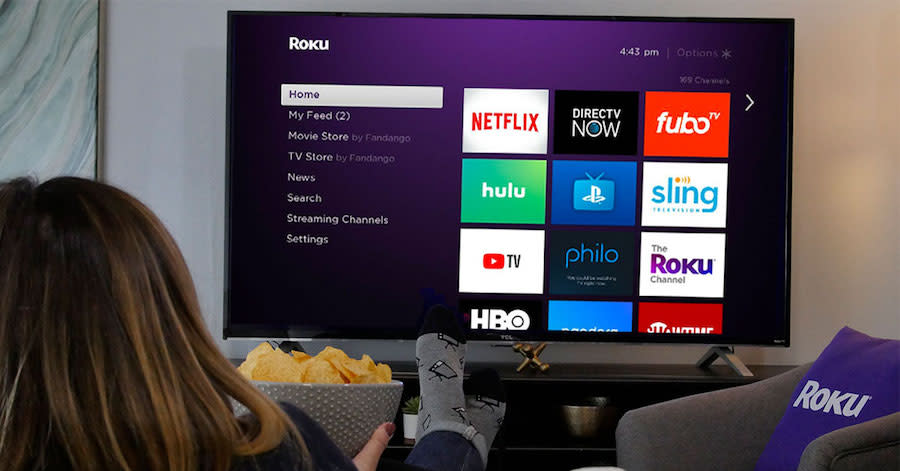Roku's Plan to Close the Gap Between Engagement and Monetization
One of the most impressive metrics from Roku's (NASDAQ: ROKU) first-quarter earnings report was that it accelerated viewing hours for a fifth straight quarter. That said, growth in viewing hours doesn't amount to much if Roku can't convince advertisers to shift their ad budgets to the streaming video platform. To that end, the streaming device maker recently introduced Activation Insights.
The new ad tool allows advertisers to analyze their reach on linear television and use Roku's platform to complement that audience. Roku can target ads to users that likely missed an ad on broadcast television and help marketers optimize their ad spend between linear television and ad-supported streaming video.
The latter point is a massive opportunity for Roku. 29% of television viewing is done via streaming, but just 3% of television ad spend goes to over-the-top platforms, according to data Roku cites from Magna Global. Providing marketers with the tools to reach viewers outside of the traditional television ecosystem should help Roku move additional ad dollars to its platform.

Image source: Roku.
A look at the average Roku user
Roku ended the first quarter with 29.1 million active accounts on its platform. Those users streamed about 8.9 billion hours of content during the first quarter, nearly 100 million hours per day. The average Roku user spends 3.4 hours per day on the platform.
By comparison, the average adult spends about 4.2 hours watching traditional television. That number is lower among younger adults: 18- to 34-year-olds spend an average of just 1.9 hours per day, and 35- to 49-year-olds spend 3.6 hours per day.
The average Roku user is also more likely not to watch traditional television, or at least not have a cable subscription. 86% of U.S. adults don't watch traditional TV, and that number falls to 73% among 18- to 34-year-olds.
So, Roku has a set of users watching similar content as traditional television and with comparable engagement levels. That said, a lot of time on Roku is spent watching content Roku can't advertise against, including Netflix (no ads) and Hulu (no stake in its ad inventory). But Roku says ad-supported streaming continues to grow faster than premium streaming on its platform. The Roku Channel is the fifth most popular channel on the platform, where it controls 100% of ad inventory, and it takes at least 30% of ad inventory on other ad-supported channels.
Roku's competition for over-the-top ad dollars
The biggest challenge to Roku's efforts to win ad budgets from traditional TV ad spend is Amazon (NASDAQ: AMZN). The online retail giant's Fire TV platform has a growing lead in global users over Roku, and it's also the most popular streaming platform in the U.S.
Amazon doesn't release user data on its Fire TV users, but it's likely they use the devices in a similar manner as Roku users. Amazon also has access to similar user data as Roku and similar ad inventory. While the Roku Channel isn't available on Fire TV, Amazon has its own ad-supported streaming service with plans to expand on it.
What's more, Amazon has a burgeoning ad business for its online marketplace, and one of its big focuses this year is on brand advertisers -- the same kind of advertisers that use traditional television. If brands are already buying ads for its marketplace, Amazon may be able to sell them streaming video ads on Fire TV more easily than Roku.
What investors need to watch long term
There are a few things investors need to keep an eye on in order to remain confident in Roku's long-term potential.
First, Roku needs to keep increasing total active accounts. Growth has been excellent so far, but Amazon is outpacing it globally. Roku is investing heavily in international markets this year, so investors should expect user growth to accelerate starting next year. Still, Amazon's presence in those markets could curb growth.
Second, Roku should keep growing average time spent per user. That's indicative that Roku is capturing a larger share of its users' TV time, increasing its chances of attracting TV ad budgets.
Finally, investors should look for continued improvements in Roku's advertising technology with tools like Activation Insights. These tools are essential for marketers, as they help move ad budgets from other platforms to Roku by showing incremental reach or improved return on ad spend.
While Amazon is currently in a better position to win incremental ad budgets, there's no reason to think both companies can't succeed in the space long term.
More From The Motley Fool
John Mackey, CEO of Whole Foods Market, an Amazon subsidiary, is a member of The Motley Fool's board of directors. Adam Levy owns shares of Amazon. The Motley Fool owns shares of and recommends Amazon. The Motley Fool recommends Roku. The Motley Fool has a disclosure policy.

 Yahoo Finance
Yahoo Finance 